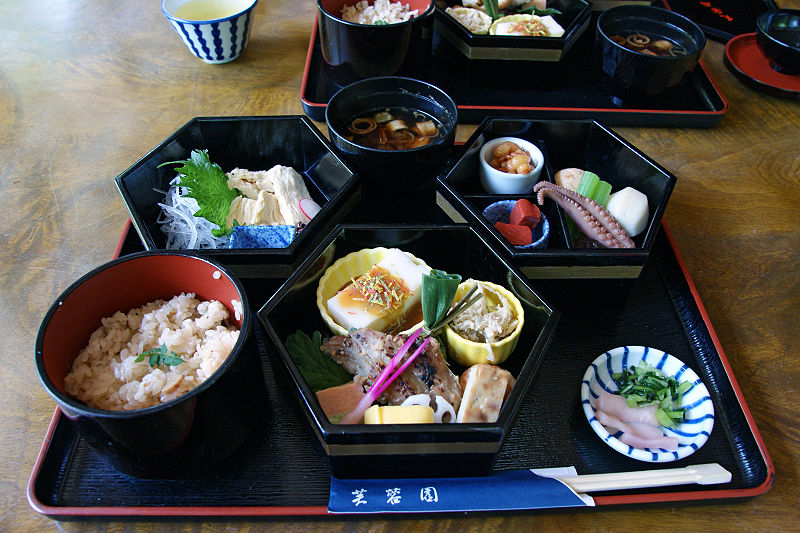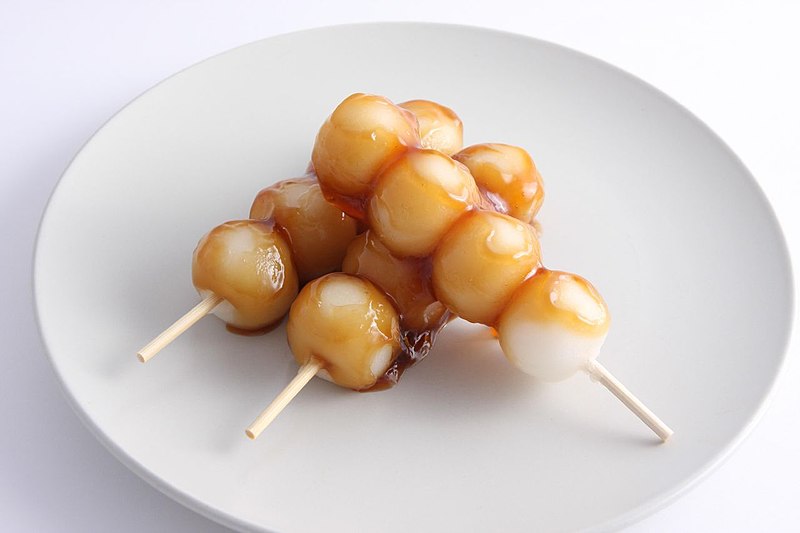










|
||
Kaiseki (懐石) or kaiseki ryōri (懐石料理) is a traditional multi-course Japanese dinner. The term also refers to the collection of skills and techniques that allow the preparation of such meals, and are analogous to Western haute cuisine.[1] There are basically two kinds of traditional Japanese meal styles called kaiseki or kaiseki ryōri. The first, where kaiseki is written as 会席 (and kaiseki ryōri, 会席料理), referring to the fancy meal served at banquets. The other is written 懐石 or 懐石料理, referring to the simple meal that the host of a chanoyu gathering serves to the guests, and which is also known as cha-kaiseki (茶懐石).[2] Okonomiyaki (お好み焼き) is a Japanese savoury pancake containing a variety of ingredients. The name is derived from the word okonomi, meaning "what you like" or "what you want", and yaki meaning "grilled" or "cooked" (cf. yakitori and yakisoba). Okonomiyaki is mainly associated with Kansai or Hiroshima areas of Japan, but is widely available throughout the country. Toppings and batters tend to vary according to region. Onigiri (御握り; おにぎり), also known as omusubi (御結び; おむすび) or rice ball, is a Japanese food made from white rice formed into triangular or oval shape and often wrapped in nori (seaweed). Traditionally, an onigiri is filled with pickled ume (umeboshi), salted salmon, katsuobushi, kombu, tarako, or any other salty or sour ingredient as a preservative. Because of the popularity of onigiri in Japan, most convenience stores there stock onigiri with various fillings and flavors. There are even specialized shops whose only products are onigiri for take out. Yakiniku (焼き肉 or 焼肉), meaning "grilled meat", is a Japanese term which, in its broadest sense, refers to grilled meat dishes. Today, it commonly refers to a Japanese style of cooking bite-sized meat (usually beef and offal) and vegetables on gridirons or griddles over flame of wood charcoals carbonized by dry distillation (sumibi, 炭火) or gas/electric grill. It is thought to have originated from horumonyaki, a dish of grilled offal, invented by Korean immigrants in the Kansai area after the Second World War. |
Dango (団子) is a Japanese dumpling made from mochiko (rice flour), related to mochi. It is often served with green tea. Dango are eaten year-round, but the different varieties are traditionally eaten in given seasons. Three to four dango are often served on a skewer. One variety of dango from Hokkaidō is made from potato flour and baked with shoyu (soy sauce). Tetraodontidae is a family of primarily marine and estuarine fish. The family includes many familiar species which are variously called puffers, balloonfish, blowfish, bubblefish, globefish, swellfish, toadfish, toadies, honey toads, and sea squab.[1] They are morphologically similar to the closely related porcupinefish, which have large conspicuous spines (unlike the small, almost sandpaper-like spines of Tetraodontidae). The scientific name, Tetraodontidae, refers to the four large teeth, fused into an upper and lower plate, which are used for crushing the shells of crustaceans and mollusks, and red worms, their natural prey. Takoyaki (たこ焼き or 蛸焼) (literally fried or baked octopus) is a popular Japanese dumpling made of batter, diced or whole baby octopus, tempura scraps (tenkasu), pickled ginger, and green onion, topped with okonomiyaki sauce, ponzu, mayonnaise, green laver (aonori), and katsuobushi (fish shavings), first popularized in Taisho-era Osaka,[1] where a street vendor named Endo Tomekichi is credited with its invention in 1935 [2]. Takoyaki can be found in shops called issen-yoshoku (壹銭洋食), which roughly translates to "one-penny Western food" [3]. There is a similarly named dish called ikayaki but it is a broiled whole squid and bears no resemblance. Yaki is derived from "yaku" (焼く) which simply means "to bake or grill" in Japanese, and can be found in the names of other Japanese cuisine items such as teriyaki or sukiyaki. Curry (カレー karē) is one of the most popular dishes in Japan. It is commonly served in three main forms: curry rice (カレーライス karē raisu), karē udon (thick noodles) and karē-pan (bread). Curry rice is most commonly referred to simply as 'curry' (カレー karē). A wide variety of vegetables and meats are used to make Japanese curry. The basic vegetables are onions, carrots, and potatoes. For the meat, beef, pork, chicken and sometimes duck are the most popular, in order of decreasing popularity. Katsu-karē is a breaded deep-fried pork cutlet with curry sauce. |
|







